The Aesthete and the Amateur Part 4: “House of Memories”
by Heavy Writer, edited by Eleanor Medier
(Please see the in-world release or download Sim Street Journal#4 for more photographs, articles, and functionality. Also available on MARKETPLACE).
An ongoing series of discussions between an unlikely fictitious couple—a professional art critic and her wise fool truck-driver husband: CONTINUES FROM PART 3.
—————————————————————————————————–
—————————————————————————————————–
Haveit Neox, “The Backyard,” from “House of Memories”
Heavy: “If Bach organ music would fit the ‘Seven Deadly Sins’ installation, I would play Jingle Bells here! This is enticing. It makes me to want to find the meaning, just because it is not so obvious like what we have seen before. This tells a story.”
Eleanor: “What story? This piece seems very busy to me, chaotic even.”
Heavy: “I see beams of light, bells, fire dragons, and butterflies. There is not just fire dragons—there are ink dragons and purple dragons. People carry them on carts. Let’s follow—it looks like all are going the same direction.”
Eleanor: “It has a carnival feeling, almost celebratory—like a parade. It feels like a fantasy, a child’s dream. There is a path with what looks like pages to follow.”
Heavy: “Please don’t tell me that scroll is the solution to the entire riddle—I don’t want this ruined by words! Zoom out and look from above. There is a tall statue, and behind that, there are more large coming up this hill. [waited] See??”
Eleanor distracted: ”Oh look! A pose ball! We can do TaI Chi! This form is Yang style. This movement is called ‘Cloud Hands’ [moved gracefully]. But I don’t know what TaI ChI has to do with this.”
Heavy: “It seems happy here—like characters from a variety of stories gather. Each bell might symbolize another story to tell. Do you see that mountain on my left? The gold one? It is like a wizard.”
Eleanor: “I can’t figure this piece out—here is a whirlwind. Different references are scattered all over.”
Heavy: “There is nothing to figure, dear. It is a dream place—or might be innocent childhood memories. I can relate to these characters. It is well realized—a bit too crowded maybe, but there is something to see on any angle.”
Eleanor: “I don’t know where to look first. Stylistically, the different parts connect together well, but are symbolically so complex.”
Heavy: “That’s the catch. When you were a little girl and your mom read you a bedtime story, you would have liked her to read all the stories. But you had to choose just one at a time. Same here—there are stories within stories, even mixed. But if you know your story, you can find it. You have recognized few characters already haven’t you?”
Eleanor: “Not really. Is it most like the Wizard of Oz? Does a skilled execution make up for a confusing idea? It seems to take study to absorb. There are clues—like the pages, the repeated figures—trying to speak without knowing what to say.”
Heavy: “That’s because you want to understand everything. Why don’t you just enjoy the happy colors, the light beams, and the magic of the place? Go back to the innocence of a kid and forget, for a moment, that you are grown up.”
Eleanor: “I want to find the story.”
Heavy: “Probably if we read that scroll, we will get to know more, but I don’t want to. I would rather daydream that I’m a kid again, to be read a story.”
Eleanor: “Awww. I like the butterflies.”
Heavy: “Darn! I couldn’t stop myself to read a page. It says: ‘DELIGHTED TO SEE I COULD SCULPT ONION DOME WITH MUD. I MADE MANY OF THEM AND STUCK THEM ON STAKES MADE OF TWIGS PAINTED THEM WITH BRIGHT COLORS AND ARRANGED THEM IN THE GROUND TO ADD TO MY OLDER CITIES. TO MY EYES THESE WERE GRAND PALACES AND EXOTIC BAZAARS THE TRUE ABODE OF ALI BABA AND FAIRYTALES.’ So it is not Oz, but AlI Baba. A kid would love this.”
Eleanor: “It is made with the innocence of a child, and the skill of an adult.”
Heavy: “Yes, the skill of an adult. Kids are sloppy, but have better vision. A kid can see the ‘Grand Palace’ from a piece of mud. He can see a magic wand in a stick found on the road.”
Eleanor: “Wouldn’t a kid care to put all this together to make sense?”
Heavy: “I think this piece tells how a child feels and sees the world. I love this freshness, even if you—the big shot art critic—don’t like it. It takes great skill and imagination for an adult to create such innocence.”
Eleanor: “It is too busy.”
Heavy: “Arabian cities are crowded—palaces and bazaars. You get lost easily. So, in its ironic innocence, this piece has realism too.”
Eleanor: “A chaotic bazaar. Happy or confused? Going around in circles? It is almost—but not quite—too cute. Even consistently derivative.”
Heavy: “I wish I would see art like this more. I’m tired of people creating half naked vamps with suicidal tendencies.”
Eleanor: “Here are large transparent figures running through the air. Maybe they got so frustrated, they jumped off the cliff. I do like things to make sense, which this piece doesn’t. Here you can let go of your preconceptions, yet you can’t when viewing abstractions!”
Heavy: “This makes sense to me.”
Eleanor: “Perhaps it makes sense in its not making sense!”
Heavy: “Who says only abstraction gives room for speculation?”
Eleanor: “Exactly dear—so you can’t suspend a literal view when looking at abstraction, but it is ok for this piece to give symbols like a riddle.”
Heavy: “I can afford to be inconsistent. I’m the amateur, remember? Anyway, abstraction does a poor job telling something. Symbolism does not tell about feelings, but creates the feelings. Most of the time those expressed feelings are sad, without hope, or with an existential viewpoint. Rothko paintings do that to me.”
Eleanor: “I don’t see Rothko’s work as negative or depressing.”
Heavy: “No, it is not depressing, but warm and welcoming, even relaxing and meditative. Rothko’s squares are not concentric and the edges are not so well defined like the ones of Albers. This is why I like Rothko better.”
Eleanor: “Because he is ambiguous?”
Heavy: “Yes. Vague is a quality in art. Albers has a German feeling to his paintings, like he says ‘this is how it is supposed to be done—this way, and only this way.’ This is why I don’t much like Albers. I don’t want the artist to tell me what I should see—I want him to make me see it myself.”
Eleanor: “Do you feel Albers tells you what to see?”
Heavy: “Yes—like he is teaching a lesson or like a scientific experiment. He says: ‘you are a square and your place is here, and you need to have this color because your neighbor has that color. You must follow the rules.’”
Eleanor: “He creates the rules as he goes.”
Heavy: “He wants you to play by his rules.”
Eleanor: “He wants you to see what he sees.”
Heavy: “No. He reduces you to a box that is contained in another box and is contained in another box—like those wooden Russian dolls that have one inside another. Who are you to question his rules? You are just a square, and not even a circle! Albers’ art is too industrial—those squares are made with an engineer’s precision. He measures everything. My Latin blood does not like such precision or rules.”
Eleanor: “I see, and I like things to at least make sense.”
Heavy: “I like a world with more shapes than just one—I like a bazaar! Chaotic, but organized at the same time—I like things to make sense too, dear. But I like to extract the sense from a pile of nonsense.”
Eleanor: “This piece makes more sense to you than to me.”
Heavy: “It makes me feel a child. At first, the dragons had me question if this is a happy place. But then the dragons are small, like babies. All babies are cute. There is a kid carrying a fire dragon on his cart—taking care of him. When I saw the butterflies, I knew it is a happy place. The colors and the lights are captivating too.”
Eleanor: “But the figures are going around and around, and many are not really here—like shadows, or ghosts. It could be considered ‘happy’—but it feels like there is something sinister underneath it all. You wonder who makes the rules here—who is in charge? It seems everyone is self-absorbed in fantasies that are secret, that will not let us in. And many of the figures are running, somewhere, but are not really here. We are here, but are they? What is real and what is not?”
Heavy: “There is a time to be literal, and a time to let go and just imagine. Why question everyting? To be a kid again is magical in itself. Your studies can make you blind to the obvious.”
Eleanor: “‘House of Memories’ could also be called ‘Questions of Reality.’”
••••••••••••••••••••••••••
This series has continued from the previous issue as Eleanor and Heavy continue to make their way through the virtual cultural landscape.
From Sim Street Journal: Issue #4 • Please click here to see contents.
(Please see the in-world release or download Sim Street Journal#4 for more photographs, articles, and functionality. Also available on MARKETPLACE).
PLEASE SEE SPONSORS FOR SIM STREET JOURNAL ISSUE #4
Contributions are encouraged if covering topics relevant to the real world readers.
Comments and opinions are also encouraged.
– – – – – – – – – – – – – CONTACTS:
Sim Street Journal explores the relevance of virtual to real commerce and culture.
ONLINE: https://simstreetjournal.wordpress.com/
FACEBOOK: https://www.facebook.com/simstreetjournal
IN-WORLD: http://maps.secondlife.com/secondlife/Innu/40/36/1650
MARKETPLACE: https://marketplace.secondlife.com/stores/148961
EMAIL: simstreetjournal@gmail.com
The Sim Street Journal explores the relevance of second to first life.
© 2014 by Eleanor Medier, Sim Street Journal. Articles cannot be reprinted without permission.

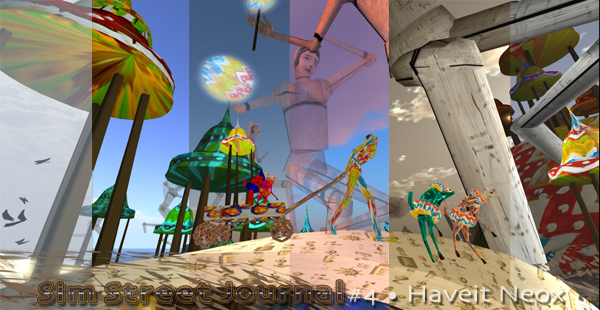
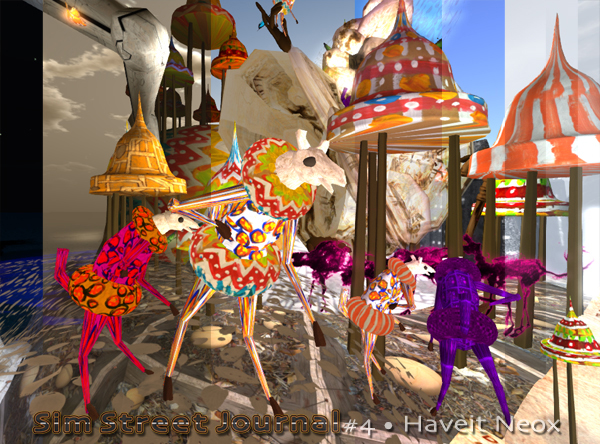
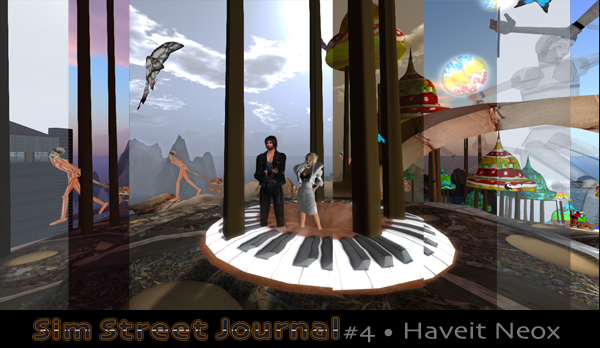
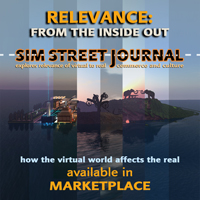
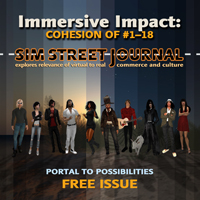






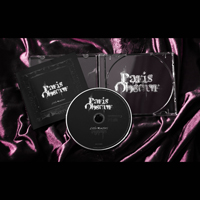

Pingback: Telling Stories | Sim Street Journal
Pingback: Champions of Expression | Sim Street Journal
Pingback: Facing the Inevitable | Sim Street Journal